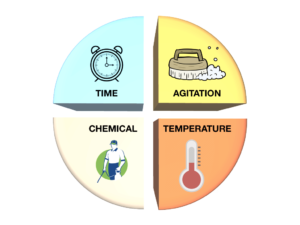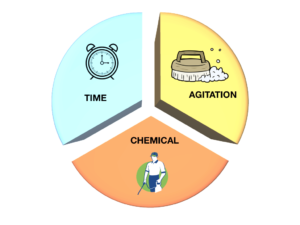Michael "Kapp" Brown | Nov 11, 2019
Many people don’t think about it, but there is a science behind cleaning that is universal across all surfaces. Whether you are talking about interior cleaning (carpets, tile & grout, etc …), and exterior (power washing, gutter cleaning, etc …), the process is virtually the same with some minor modifications.
This process involves 4 components – Time, Agitation, Chemical, and Temperature. To help you remember just think T.A.C.T. When these 4 components are used in proper proportions, effective cleaning can occur. Let’s look at each of these a bit further …
 TIME. This is a measure of time that the solutions or chemicals applied need to “dwell” on the surface in order for it to break down the soils. It can be measured in seconds, minutes, or hours.
TIME. This is a measure of time that the solutions or chemicals applied need to “dwell” on the surface in order for it to break down the soils. It can be measured in seconds, minutes, or hours.
AGITATION. This can be as common as scrubbing a surface with an appropriate brush or pad. It can also be applied by water pressure as in power washing or gutter cleaning. For the most part, by providing some agitation to the surface, you assist the chemical action to occur, and broadcast the chemicals over a larger and deeper surface.
CHEMICAL. This applies to the solution that is applied to the surface in conjunction to a wetting agent (ie. Water). The chemical can be applied as a pre-spray, or in direct application with your cleaning equipment. The type of soiling plays a vital role in knowing which solution is needed to clean it.
TEMPERATURE. This typically refers to the temperature of the water being used to clean the surface. Water is a very effective cleaning solution, but when temperature is added, cleaning efficiency is increased. Temperature should also be adjusted based on the cleaning situation as some textiles don’t handle heat very well.
Now when all 4 are working in sync and proportion, you have a very effective cleaning solution.

However, if one is decreased, the other three have to be increased to ensure an effective cleaning. For example … if you are cleaning a floor with a rental cleaning machine, and the water you are using is cold or moderately warm, you will need to have a longer dwell time, stronger chemical, and more agitation to achieve the same results. Likewise if your water is hot, but your chemical is too low a pH to be effective, you will need longer dwell time, and stronger agitation.
So after reading this, hopefully you realize that there is a science behind cleaning after all. Having a better understanding of how using these four elements in your cleaning process will ensure a more successful cleaning experience. So the next time you have something difficult to clean, remember to use TACT!
